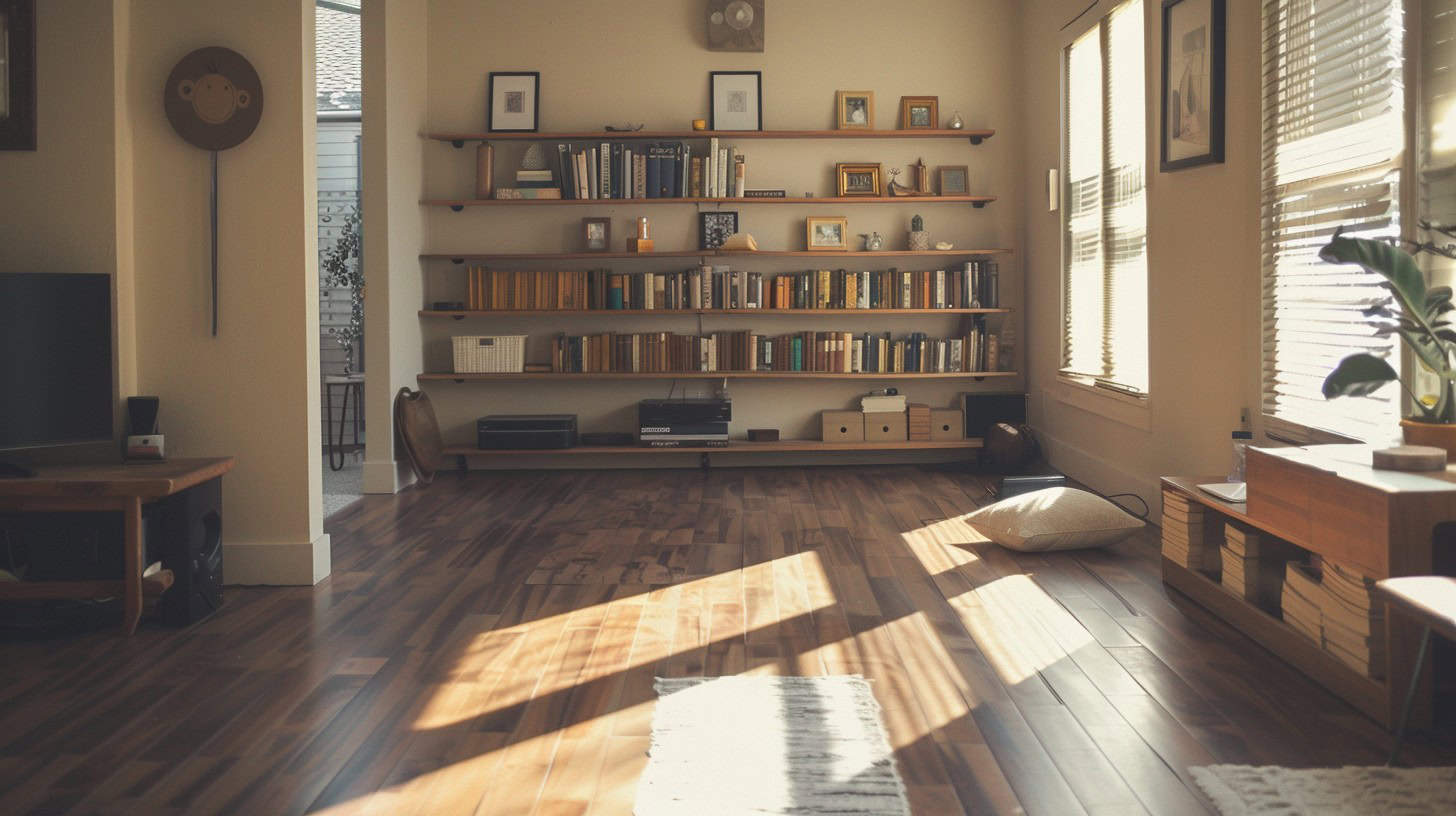Feeling overwhelmed by the mess in your house? You’re not alone. This article will guide you through seven easy steps to turn your home into a stress-free haven.
Let’s make space for joy.
Key Takeaways
Decluttering means removing things you don’t use or need, aiming to make your home less crowded and more joyful. It’s about keeping items that add value to your life.
Nearly half of Americans feel stressed by clutter at home. Tackling clutter can reduce stress and make homes feel more inviting, making it important for mental well-being.
Start decluttering by setting clear goals and sorting items into keep, donate, and throw away piles. This makes the process manageable and helps create a peaceful living space.
Getting rid of items can involve selling them, donating to charity, or recycling. Proper disposal helps reclaim space in your home and supports environmental responsibility.
Regular decluttering practices include setting aside time each day for small tasks and ensuring everything has its place. This keeps homes tidy long-term without overwhelming residents.
Table of Contents
The Basics of Decluttering
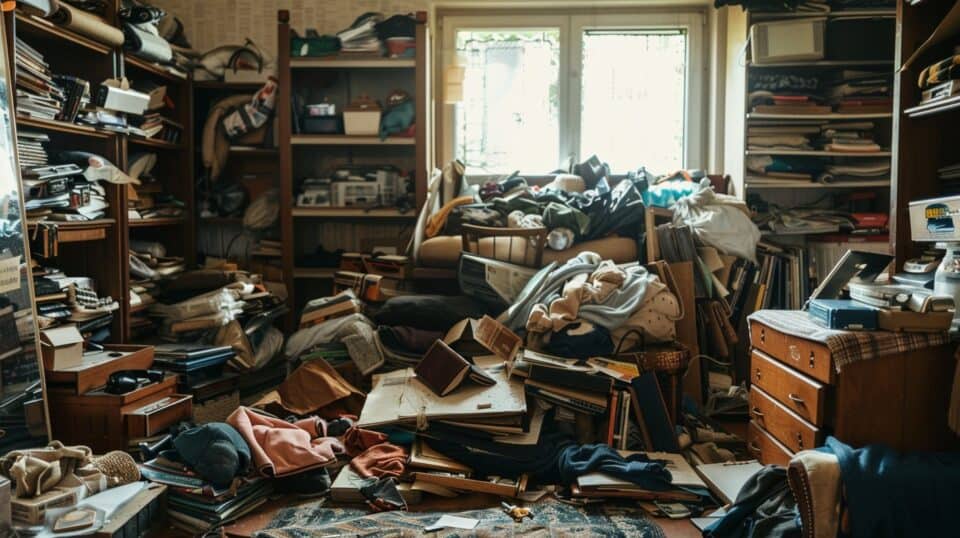
Decluttering means making your space less crowded by removing things you don’t need. It’s like creating a breath of fresh air in your home, pushing out anything that takes up too much room.
Defining Decluttering
Decluttering means getting rid of stuff you don’t need or that doesn’t make your life better. Think about kitchen cabinets stuffed with gadgets you never use, or a closet full of clothes you never wear.
It’s like peeling an onion, layer by layer, until only the things that matter remain. This process isn’t just about making space; it’s about choosing to surround yourself with items that add value and joy to your everyday life.
Clutter is anything that doesn’t add value to your life.
Knowing this, the necessity of decluttering becomes clear. It’s not merely tidying up; it’s creating an environment where every item in your home earns its keep. Let’s talk next about why ditching the clutter is a game-changer for any household.
The Necessity of Decluttering
Getting rid of clutter is more than just cleaning; it’s about creating a stress-free sanctuary. With 75% of Americans tackling declutter projects last year, the push to purge has never been stronger.
Clutter isn’t just old magazines or unused cooking gadgets; it’s anything that doesn’t add joy or value to your life. Imagine walking into a room where everything has its place, and you feel calm instead of overwhelmed.
That’s the power of decluttering.
It does wonders for your mind too. Nearly half the people say clutter makes them stressed, and who needs more stress? Not parents, that’s for sure. Making space in your home also means making space in your head for what truly matters: family time, relaxation, and hobbies that make you happy.
Letting go of things can be tough but think about this: Decluttering isn’t losing; it’s choosing—choosing peace over chaos and memories over stuff.
Decluttering’s Role in a Household
Decluttering keeps a house feeling like home. It cuts down on stress and embarrassment from too much stuff lying around. Imagine walking into a room where everything has its place, and you can easily find what you need.
That’s the power of decluttering. It makes our homes more inviting and our lives simpler.
By sorting through belongings, we let go of things we don’t use or need. This process frees up space in our closets, shelves, and countertops. Decluttering isn’t just about getting rid of physical items; it’s about creating more room for experiences with family and friends.
With less clutter, cleaning becomes easier, making more time for what truly matters—bonding with loved ones.
Clutter’s Influence on Well-being
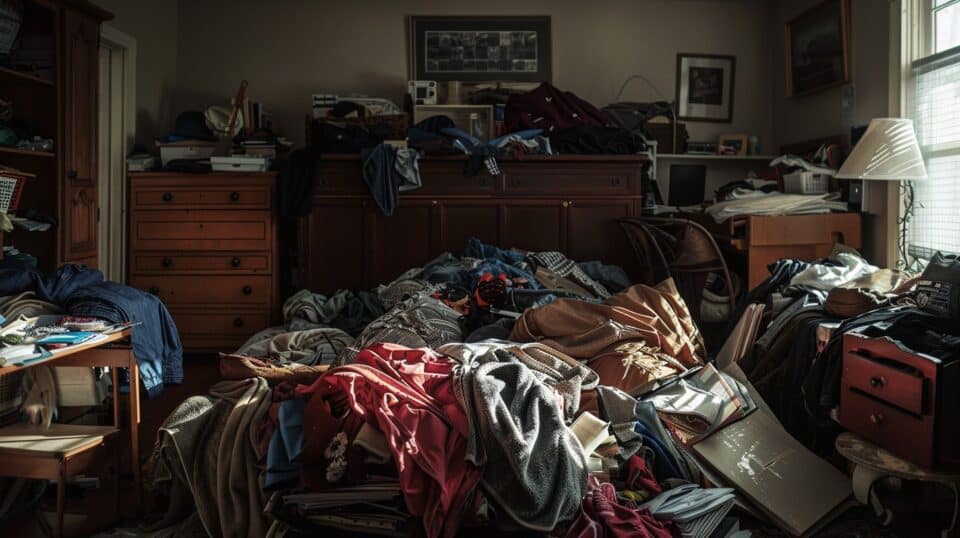
Clutter acts like a thief, stealing your peace and creating chaos in your mind. Living in a mess can make you feel stuck and overwhelmed, making it hard to breathe easy and enjoy your home.
The Stress-Clutter Connection
Nearly half of us say that too much stuff at home makes us stressed. Imagine your kitchen counters buried under cooking utensils and mail, or your living room drowning in toys and magazines.
This mess does not just eat up space; it nibbles on our peace of mind too. Stress spikes because our eyes can’t rest easy with clutter around. It’s like trying to find calm in a storm.
A clear space equals a clear mind.
With stress levels dropping for over 60% of people who cut down clutter, it’s clear: getting rid of excess brings back the zen. Think about walking into a room where everything has its place—feels good, right? That’s because spaces invite calmness instead of stressors when they’re tidy.
Your emotional health gets a big boost from simply deciding which items stay and which ones need to go visit Goodwill.
Advantages of a Decluttered Environment
Clearing out clutter does wonders for your well-being. About half of parents say that mess in the house stresses them out. Imagine cutting that stress in half! A tidy home means you spend less time searching for lost items like keys or the TV remote.
You also waste fewer weekends tackling a mountain of cleaning, giving you more moments to enjoy with family.
A decluttered space boosts your mood too. Seeing clear countertops and organized shelves makes rooms feel inviting and calm. It’s all about making spaces work better for you, not against you.
Plus, 61% of folks found their anxiety levels dropped after decluttering, showing it’s a surefire way to lighten your mental load. Think less chaos and more peace – doesn’t that sound nice?
Initiating the Decluttering Journey
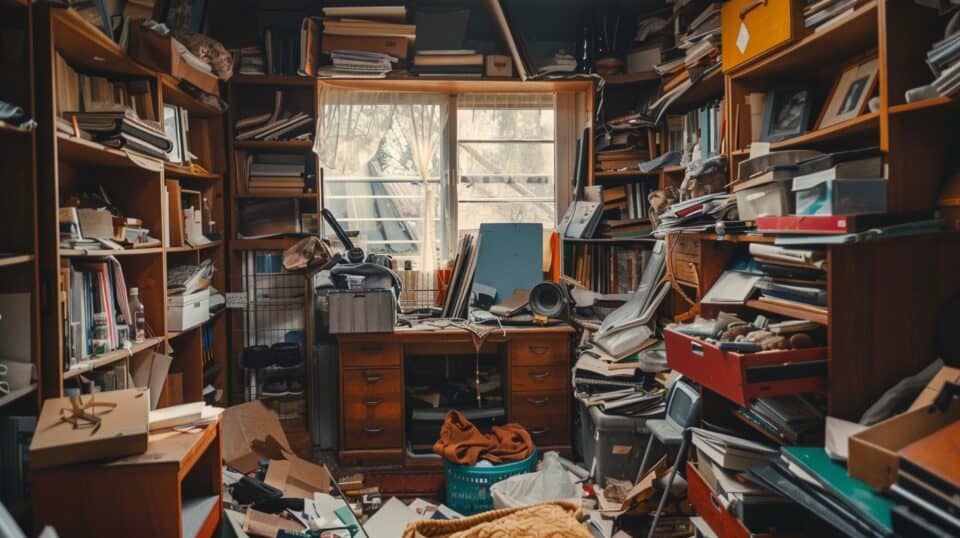
Starting your decluttering adventure means setting clear goals. Grab a calendar and some labels, then dive into sorting out what stays and goes.
Goals and Timelines for Decluttering
Set clear goals and realistic timelines to make your decluttering journey feel like a walk in the park, not a marathon. Aim to tackle one area at a time—maybe start with that messy dresser or overstuffed shelf—and give it all you’ve got until it screams, inviting home. By breaking it down, say cleaning out a drawer each day or setting aside 15 minutes for sorting, you’ll chip away at the clutter without burning out.
This method keeps things manageable and morale high.
A stressed-out parent’s mantra: ‘I will conquer clutter one drawer at a time.’
Decluttering is not just about tossing things; it’s about creating spaces that breathe life into your home and heart. Use tools like bullet journals to track your progress or set reminders on your phone so nothing slips through the cracks.
Each ticked box is a step closer to less mess and more peace. Celebrate small victories because every cleared surface is an achievement worth noting in this ambitious project of making your house feel more like home again.
Developing a Sorting Strategy
Jump right in by creating three piles: keep, donate, and toss. This makes it easier to decide the fate of each item without getting stuck on the small details. Use baskets or boxes to separate these categories physically.
Making decisions can be tough, especially with sentimental items like your kid’s first drawing or that T-shirt from college. Here’s a trick: if you haven’t used it in a year, and it doesn’t bring you joy or utility, consider letting it go.
Next up, tackle one room at a time to avoid feeling swamped. Start with high-traffic areas like the living room or kitchen. This approach keeps things manageable and gives you quick wins that motivate further cleaning.
Keep an eye on the timer; setting it for 15 minutes helps maintain focus without burnout. Ready to move on? Let’s dive into disposing of decluttered items effectively.
Disposing of Decluttered Items
After sorting through your stuff, it’s time to decide what goes and what stays. Selling items can put a little extra cash in your pocket. Yard sales or online marketplaces like Amazon.com are great spots to start.
Donating is another fantastic option. Local charities and shelters always need goods. Make sure to get a receipt for tax deductions.
For items that can’t be sold or donated, consider efficient junk removal services. For clean outs and junk removal, Minneapolis residents tend to pay an average of $270 per junk removal job, which is mid-range when compared to the rest of the United States. This option is particularly sensible if you’re dealing with bulky items. For those with hazardous waste like batteries or paint, be sure to consult local disposal guidelines.
Freecycle and Facebook Marketplace are also smart ways to find people who might need what you don’t. Keep recycling in mind too; paper, glass, and plastic can often be picked up curbside.
Taking care of our planet starts at home after all.
Fundamental Decluttering Principles
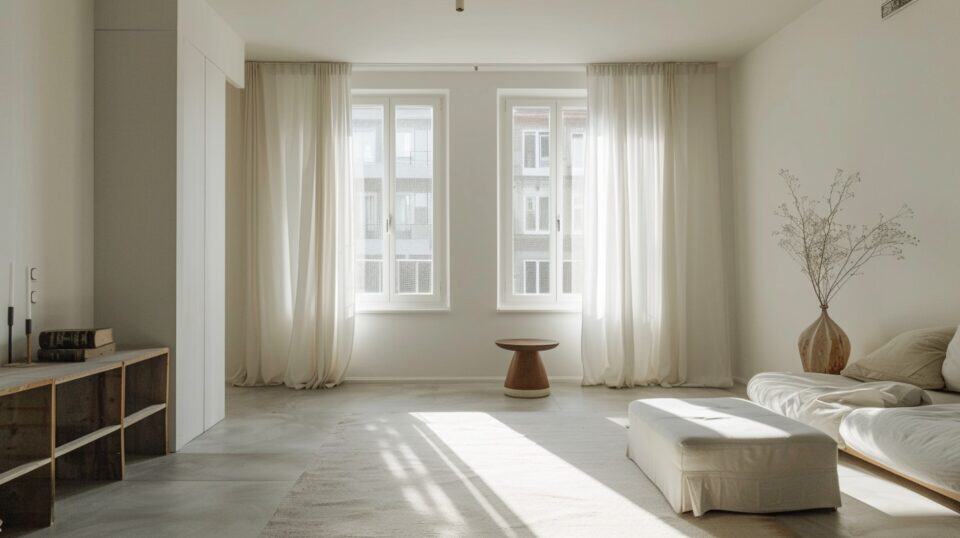
To make your house feel like a true sanctuary, follow these key decluttering rules: plan your attack, find a home for everything, know when to stop, let go of guilt, and clean regularly.
Ready to turn chaos into calm? Keep reading!
Planning Your Decluttering Effort
Map out your battle plan before tackling the clutter jungle. Pick a day, grab your calendar, and circle it. This is D-Day for decluttering. Jot down what rooms you’ll hit first and how much time you’ll spend in each spot.
Make it as fun as playing a game of Tetris with your home’s layout. Keep things sharp but flexible; some areas might need just a quick sweep while others are like peeling an onion.
A place for everything, and everything in its place.
Mark spaces in each room where items will live happily ever after. Use colorful stickers or tags to help everyone remember where things go – this turns cleaning up into a find-and-place treasure hunt for kids (and let’s be honest, adults too).
By giving every sock, spoon, and toy car its parking spot, you dodge the chaos of tomorrow’s rush hour. Remember, 75% of Americans have rolled up their sleeves for such missions last year – now it’s your turn to join the brigade!
Designating Spaces for Items
After you map out your decluttering project, it’s time to decide where everything should go. Give each item a home. This makes cleaning up easier for parents who don’t have much free time between work and taking care of kids.
Use baskets for toys in the living room, shelves for books in the bedroom, and boxes in the basement for seasonal decorations. This way, you know where to find things without turning the house upside down.
Sort items by how often you use them. Keep everyday tools like scissors and tape on your desktop or kitchen counter. Store rarely used gadgets like deep fryers or fabric softeners on high shelves or at the back of closets.
This keeps your counters clear and makes your space feel more like a home without extra clutter crowding your style.
Determining a Decluttering Endpoint
Now that we’ve talked about giving every item a home, it’s time to figure out when to stop. Setting an endpoint for decluttering can seem like finding the end of a rainbow. But think of it this way: You’re aiming for less stress and more space – not perfection.
It’s like saying goodbye at a huge family gathering; you don’t wait until everyone leaves, but when you’ve hugged all your favorite people.
Use clear goals as your guide. Maybe it’s getting rid of 50% of the unused gadgets in the kitchen, or ensuring every article has its place in the closets. Feel proud when you hit these marks! Decluttering isn’t forever cleaning; it’s reaching a point where your house feels like home again without becoming overwhelmed by possessions.
Keep this journey simple and focus on making each room breathe easier, one step at a time.
Overcoming Guilt in Decluttering
After you’ve set your decluttering finish line, it’s time to tackle the guilt that often comes with letting go of things. Feeling guilty is common, especially when tossing out items loaded with memories or gifts from loved ones.
Think of decluttering as creating space for new stories in your home. It’s not about losing memories but making room for more joy.
It’s easier to let go when you realize it’s the memory that matters, not the object.
Give each item a moment of gratitude before saying goodbye. This simple act can ease the sting of parting ways with sentimental stuff. Remember, keeping your house a stress-free sanctuary benefits everyone in it – turning “housework” into “home enjoyment”.
So, shed the guilt and embrace the peace that comes from less clutter.
Routine Decluttering Practices
Make decluttering a daily habit. Set a timer for 15 minutes and tackle small piles or drawers. This trick keeps the task manageable and prevents burnout. Also, focus on high-traffic areas like kitchens and living rooms first; they’ll give you the biggest sense of achievement.
Keep a basket in each room for things that don’t belong there. At the end of the day, take five minutes to put everything back where it goes.
Regularly ask yourself if items are useful or bring you joy. If not, out they go! Have separate bins for trash, recycling, donations, and items to sell. This system makes disposing of things much easier since you already know where everything should go.
This practice not only tidies your space but also helps clear your mind.
Next up: Dive into effective home purging tactics to transform cluttered spaces into serene sanctuaries.
Effective Home Purging Tactics
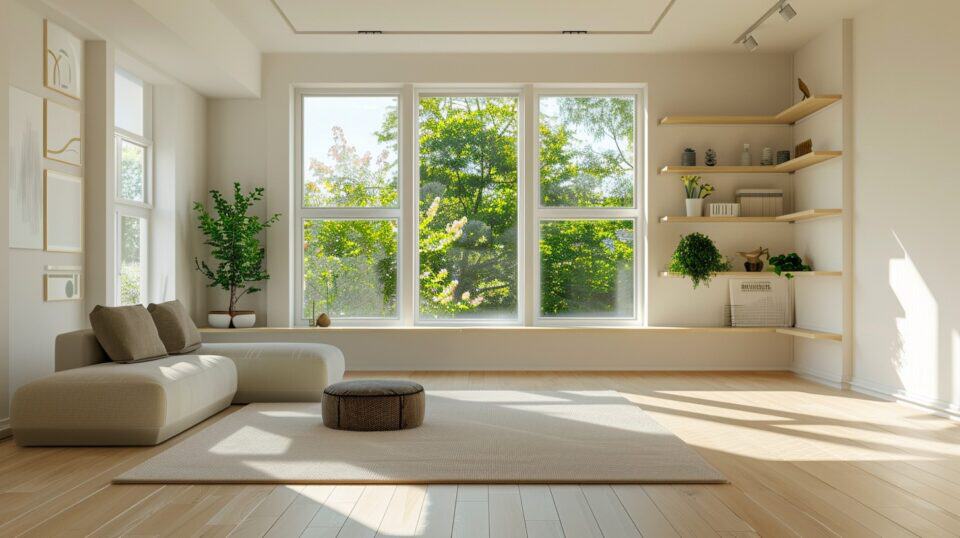
To make your home feel like a breath of fresh air, start with smart purging tactics. Cut the clutter by tossing out what you don’t need and keeping only what brings joy. Think about those jeans you haven’t worn in a year or the stack of magazines collecting dust.
It’s time to say goodbye. Tackling one room at a time makes this huge task less scary. And guess what? You might just find that blender buried under all that mess when you thought it was gone for good! Dive into these strategies and watch as each room transforms from chaos to calm oasis, making your house truly feel like home again without relying on overthinking or hoarding every little thing.
Embracing the 80/20 Decluttering Principle
The 80/20 decluttering principle is like a secret weapon for parents who want a stress-free home. This rule says to toss out things we don’t use 80% of the time. Imagine your house with only items that make life easier and happier.
It’s all about keeping the goodies and saying goodbye to the rest. Think of it as choosing quality over quantity in your cozy nest.
Now, picture tackling your clutter with this savvy approach. Start small, maybe with a single drawer or shelf, and apply the 80/20 magic. Notice how much space you free up! It makes room not just in your home, but also in your mind for what truly matters.
And for those special yet seldom-used items? Consider selling or donating them to spread joy elsewhere while decluttering your space. This way, you lighten your load without losing memories attached to these treasures.
Ignoring Sunk Costs
Sunk costs often trip up even the savviest of parents. You bought that fancy food processor, thinking it would turn you into a master chef overnight. Now, it just collects dust on your kitchen counter.
It’s tough admitting that money might as well have gone down the drain, but clinging to stuff because of past cash spent won’t clear your space or mind. Letting go means focusing on what an object brings to your life now, not its price tag from yesterday.
Cutting ties with items isn’t about losing out; it’s gaining room for what truly matters. That stack of books gathering cobwebs? If they’re more decoration than knowledge source these days, it’s time they found a new home.
Think about the joy and peace a clutter-free space brings. It beats holding on to things out of guilt any day. Shed those old buys like last year’s skin and breathe easier in your tidy nest.
Beginning with Minor Projects
Start small to win big. Tackling a jam-packed closet or a cluttered basement might seem like climbing Mount Everest in flip-flops. Instead, pick something easy, like a single drawer or the pile of mail on the kitchen counter.
This approach not only makes the task less scary but also gives you quick wins. Remember, 75% of Americans found joy and momentum in completing smaller decluttering tasks last year.
As you conquer these mini mountains of mess, your confidence will grow. Suddenly, what seemed impossible – saying goodbye to that broken toy or outdated gadget – becomes doable.
Keep things moving by swiftly dealing with each little project before it can intimidate you. Next up: tackling flat surfaces for an even bigger impact.
Decluttering Flat Surfaces First
Clearing off countertops and tables can make a big difference. Picture your kitchen or living room before and after you tidy up these spaces. Suddenly, the whole area looks better.
It’s like making your bed in the morning; it sets the tone for the whole room.
Tackle those easy-to-reach zones first. This approach helps you see quick wins, making you feel good about your progress. Plus, clean surfaces are easier to keep that way. As soon as you clear a spot, decide what deserves to go back and what doesn’t.
Keep only what you use daily within arm’s reach; everything else can find a new home or leave yours for good.
Grouping Like Items
After you’ve tackled the clutter on counters and tables, it’s time to sort items by category. This makes everything easier to find and put back where it belongs. Start with your clothes, toys, or kitchen gadgets.
Put all similar things together in one spot. This way, you’ll see exactly what you have and what you use most often.
This method shines a light on duplicates or rarely used items hiding in your home. For instance, if you gather all your cooking utensils together, you might find four spatulas when you really only need two.
It’s like having a bird’s-eye view of your stuff, which helps make decisions on what stays and what goes much simpler. Plus, this approach supports the idea that less is more by showing how fewer items can actually serve our needs better than a mountain of belongings we hardly ever touch.
Verifying Item Functionality
Check if things work right. Plug in the toaster and see if it can still make your breakfast crispy. Try turning on that old lamp in the corner. If they don’t light up or warm up, it’s time to say goodbye.
This step cuts down the clutter by removing broken gadgets and appliances you no longer use.
Give each toy a test run too. Sometimes, toys sit on shelves gathering dust because they’re out of batteries or simply don’t entertain the kids anymore. Sorting through them helps keep only those that bring joy and laughter into your home, making room for new memories without extra mess around bedrooms and play areas.
Monitoring Item Usage
Keep track of what you really use. Flip items around after using them. This trick helps parents see at a glance which things they haven’t touched in months. If something hasn’t moved in a year, consider it time for that item to go.
It’s like playing detective with your own stuff, but the clue is how often you reach for it.
This method ties into analytics of a different kind – home analytics! By monitoring usage, you create an inventory system without needing complex software or spreadsheets. Just visual cues in your living space guiding your decisions.
Next up: figuring out if each item is truly necessary adds to the decluttering process.
Assessing Item Necessity
After you’ve watched how often you use something, it’s time to ask yourself if you really need it. Think of your house as a busy airport. Every item is like a passenger with a ticket to board.
Some have clear destinations—like the washing machine heading straight to laundry duties or shelving units flying off to store your treasures. But then there are those without a purpose, just taking up space.
Ask each item, “Do I need you for my journey ahead?” If the answer’s no, it might be time for them to take off for good.
This step forces us to look at our belongings with fresh eyes. Imagine holding up that gadget that was all the rage on social media platforms but now collects dust in a drawer. Or consider those pastimes hidden under the bed because life got too busy.
If these items don’t help your day-to-day mission or bring joy, they’re likely cluttering your space and mind more than anything else. Making tough calls on what stays and goes turns your home into less of an overstuffed suitcase and more of a carefully packed carry-on, ready for whatever adventures lie ahead.
Reevaluating Emotional Attachments to Items
Tackling emotional ties to objects is a big step. It’s like sorting through a box of old photos. You find things that tug at your heart. But, not everything can or should stay. Think about the joy an item brings now, not just in the past.
If it no longer fits your life, consider passing it on. Selling or donating sentimental belongings frees up space and keeps the good vibes flowing.
Next comes reflecting before final choices.
Reflecting Before Final Decisions
Take a moment to think deeply before saying goodbye to your items. Ask yourself if the joy it brings matches its space on your shelf. Imagine your home as you wish it to be: neat, peaceful, and with plenty of room for new memories with friends and family over things.
This step is like hitting the pause button during a movie; you give yourself time to make sure each choice fits into the bigger picture of your decluttering journey.
Reflecting goes beyond just keeping or tossing stuff out. It’s about understanding why some belongings tug at our hearts more than others. Do they remind us of good times, or do we keep them around “just in case”? Sometimes, sharing what we no longer need can bring someone else happiness.
So take that break, sip some tea, and let wisdom guide you through the final stretch of making your house a stress-free sanctuary where every item has purpose and meaning.
Targeted Decluttering Guide for Each Room
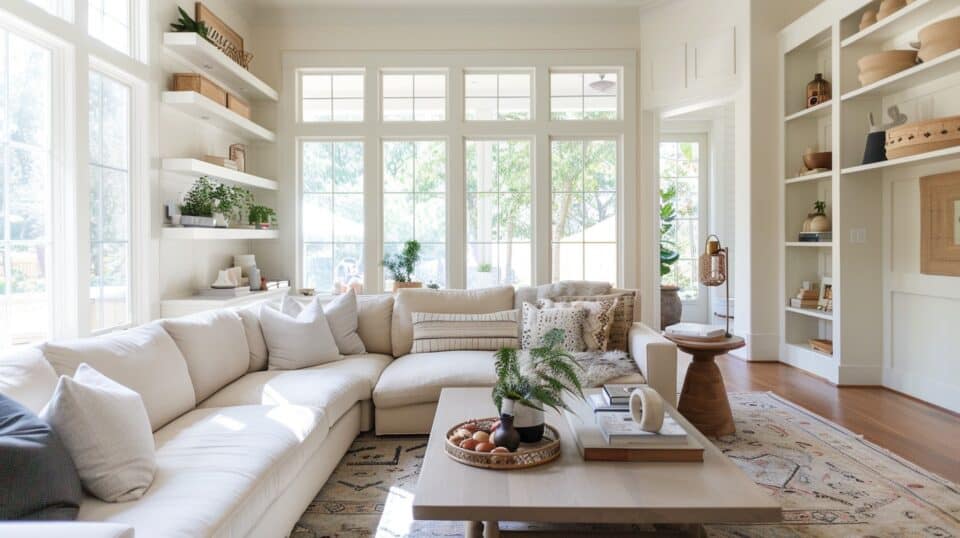
Each room holds its own clutter secrets, waiting for you to unlock them. Dive into our guide and find out how to tackle each space, from bedrooms to cooking areas, making your house a true stress-free sanctuary.
Bedroom Decluttering
Start by tackling the mountain of clothes in your sleeping space. Sort them into piles to keep, donate, or toss away. Keep what makes you happy and what you wear often. This step alone can make a big difference in how you feel when you enter the room.
Next, look at your nightstand and dresser tops. These areas tend to collect random items like books you finished reading months ago or electronics that no longer work.
For parents, creating a calm oasis where relaxation is key means keeping only essentials nearby. Use boxes or baskets for storing smaller items out of sight but still within reach.
This approach not only clears the surface clutter but also helps reduce stress from looking at too many things before bedtime. Clearing out under the bed can also unearth forgotten treasures or junk that’s been hiding for years, freeing up more space and making cleaning easier.
Closet Organization
Tackle your closet with gusto. Empty it first to see everything you’ve got. This step alone can make a big difference. Sort clothes into piles: keep, donate, or toss out. Be honest with yourself about what you actually wear and need.
Use baskets, hangers, and dividers to keep things neat inside the closet after sorting. Hanging shelves work wonders for sweaters and jeans, while shoe racks keep footwear in order.
Giving each item a designated spot makes mornings smoother for busy parents.
Living Room Space Maximization
Maximize your living room by choosing furniture that serves more than one purpose. Think about sofas that turn into beds or coffee tables with storage space underneath. This trick makes the area feel bigger and keeps clutter out of sight.
Use shelves up high for books, keeping floor space clear for play and relaxation.
Install hooks behind doors to hang coats or bags, freeing up even more space. Brighten the room with mirrors across from windows to make it appear larger and lighter. By purging junk, you save time on cleaning and gain more room for family fun in a tidy space.
Home Office Cleanup
Tackling your home office starts with sorting papers, files, and data. Create piles to keep, recycle, or shred. It’s easy to let these items pile up until they take over desks and shelves.
Use folders or digital storage solutions for the keepers. This keeps important documents safe and your workspace clear.
Next up, tackle the tech clutter. Wrangle those cords, donate gadgets you no longer use, and organize your digital desktop. Keeping only what you use daily makes finding what you need faster and reduces stress.
A clean desk boosts focus and creativity for parents juggling work and family from home.
Kitchen Organization
Kitchen clutter steals your joy and saps time better spent with family or on yourself. Sweep through your kitchen, parting with gadgets you no longer use. Clutter is just stuff weighing down your countertops without purpose.
A “time-out” bin works wonders. Toss items in there you’re unsure about. After a month, if you haven’t missed them, say goodbye for good. This trick reveals the real gems in your cookspace.
Organizing doesn’t stop after one big clean-up; it’s an ongoing game of keep or toss. Containers can be friends that help sort utensils and cutlery or foes that add to the mess if overused—choose wisely.
Remember how 61.7% felt less stressed after decluttering? Aim to join them by keeping only what turns cooking into pleasure, not a chore. Next up: tackling bathroom simplification brings its own set of challenges and rewards.
Bathroom Simplification
After tackling the kitchen, let’s move on to the bathroom. This space can quickly turn into a clutter zone, with half-used products and towels everywhere. Start by tossing out expired medicines and skincare products.
It feels good to clear out things that just take up space! Next, group similar items together in drawers or bins. Keep counters clear by storing toothbrushes and soaps in a cupboard or using wall-mounted holders.
For families, having a basket for each person keeps personal items separate and organized. Weekly checks keep clutter at bay; it’s like having a mini declutter session every seven days! Don’t forget to give those toys a home too – use mesh bags or bins so they’re not underfoot but still within reach for bath time fun.
Simplifying your bathroom is not just about making it look good; it’s about creating a stress-free start to your day.
Laundry Room Efficiency
Moving from the bathroom to another crucial part of your home takes us to the laundry area. Keeping this spot in tip-top shape can turn a chore into a breeze. Start by sorting clothes right away; use baskets for colors, whites, and delicates.
This saves time and prevents last-minute scrambles. Install shelves above or beside your washer for detergents and supplies, keeping everything within arm’s reach.
Opt for hooks or hangers nearby to immediately hang clothes that can’t tumble dry. Think about a folding station too, even if it’s just a small table. This way, clothes go from dryer to drawer without piling up on the nearest chair or bed.
A well-organized laundry room isn’t just nice to look at; it makes the task faster and simpler for busy parents trying to juggle life’s other demands.
Basement or Attic Clear-Out
After sorting out the laundry room, it’s time to tackle the basement or attic. These areas often become storage for things we don’t use daily but aren’t ready to throw away. Start by dividing your space into sections.
This helps you not feel overwhelmed. Then, take everything out one zone at a time and decide if you should keep it or get rid of it.
For those items, you choose to keep, think about putting them in containers. It keeps things neat and makes finding them easier later on. Seasonal decorations and kids’ toys work great in these bins.
If you find books you no longer read, consider donating them to a charity book sale. Clearing out these spaces can be a big job, but breaking it down into smaller tasks makes it manageable.
Garage Organization
Tackling the garage can feel like facing a dragon in its den. Yet, with 75% of Americans on a decluttering spree, it’s your turn to join the quest. Start by pulling everything out into the daylight where you can see it clearly.
Sort items into groups: keep, donate, sell, or toss. You’ll find treasures buried under forgotten junk—things you thought were lost forever.
Next up, think about smart storage solutions. Shelves and cabinets are your best friends here because they take back wasted vertical space. Use clear bins for small stuff like screws and nails so you can spot them easily without opening ten boxes first.
Label everything! This way, when life throws a curveball (like needing that one specific tool for an unexpected repair), finding what you need won’t turn into an epic saga of its own.
Remember to give bikes and sports gear their spots too; hooks and racks do wonders for keeping these bulky items off the floor and organized.
Strategies for a Clutter-Free Lifestyle
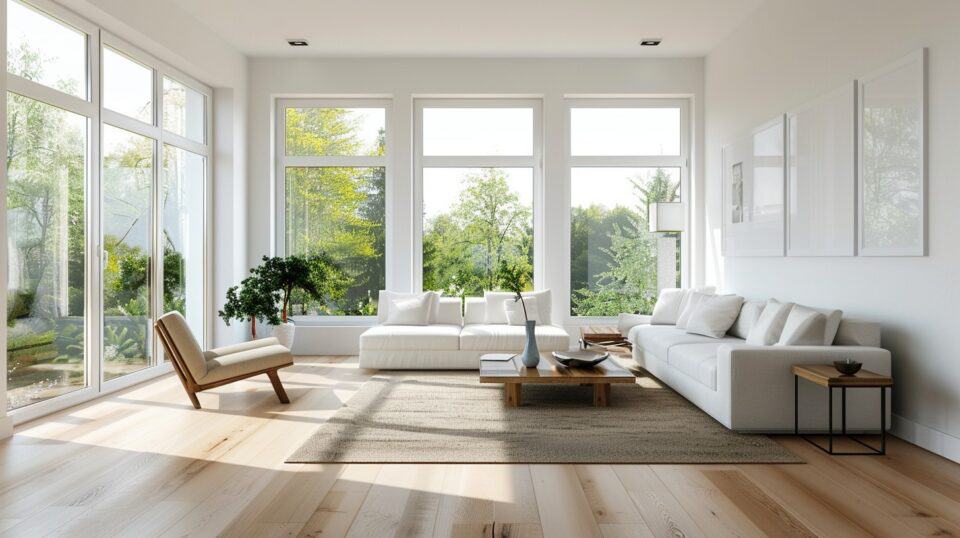
Stepping into a clutter-free life is like opening the door to a fresh, calm world. Think of it as keeping your ship sailing smooth without any extra weight pulling you down. To stay on this path, kick off each day with a quick pick-up round in your living spaces.
This simple habit can work wonders! It’s like having an invisible shield that keeps the mess at bay.
Also, consider adopting the ‘one in, one out’ rule. If a new toy or gadget comes home, say goodbye to an old one. This method helps keep things balanced and prevents piles from growing back.
Another smart move is to choose experiences over more stuff whenever you can. Instead of another shelf-filler, how about tickets to a water park or a family cooking class? These memories don’t take up space on your shelves but fill pages in your memory book.
Lastly, let’s not forget about digital clutter – yes, it’s a thing! Make some time every month to clean out those old
Preventing Clutter Accumulation
Keep clutter at bay with daily tidy-up tricks. Make it a game for the kids: who can pick up ten items the fastest? This keeps your living spaces neat and teaches them good habits. Use baskets in every room for quick clean-ups.
At night, take five minutes to clear counters and tables. This small habit stops clutter from taking over.
Choose quality over quantity when buying new things. Ask yourself, “Do I really need this?” before you buy. Borrow books from the library instead of buying them to reduce home clutter.
Rent tools or equipment for once-off projects instead of purchasing them to store in your garage forever. By being mindful about what comes into your home, you control what needs tidying later on.
Daily Decluttering Habits
Make decluttering a game, not a chore. Spend 10 minutes each day tossing unused toys or sorting through that mountain of mail on the kitchen counter. This daily mini-cleanup keeps your house tidy without feeling like a second job.
Imagine finding everything you need without playing hide and seek in your own home!
Next up, tackle those overflowing closets and drawers. Turn on some tunes and dive in. You’ll thank yourself later when you’re searching for that one shirt and actually find it. Ready to see what’s hiding in your closet?
Opting to Rent or Borrow
Choosing to rent or borrow items can save space and money. Parents often feel they need everything for their home, from bread machines to power washers. But many of these are used just once in a blue moon.
Instead of buying, ask friends if you can use theirs. Or find local rental shops. This way, your house stays clutter-free.
Renting big tools or party supplies is clever too. It keeps your garage and closets open for what truly matters – memories with family and fun times with friends, not stuff you hardly use.
Next up, let’s explore the perks of a minimalist lifestyle in your home.
The Advantages of a Minimalist Home
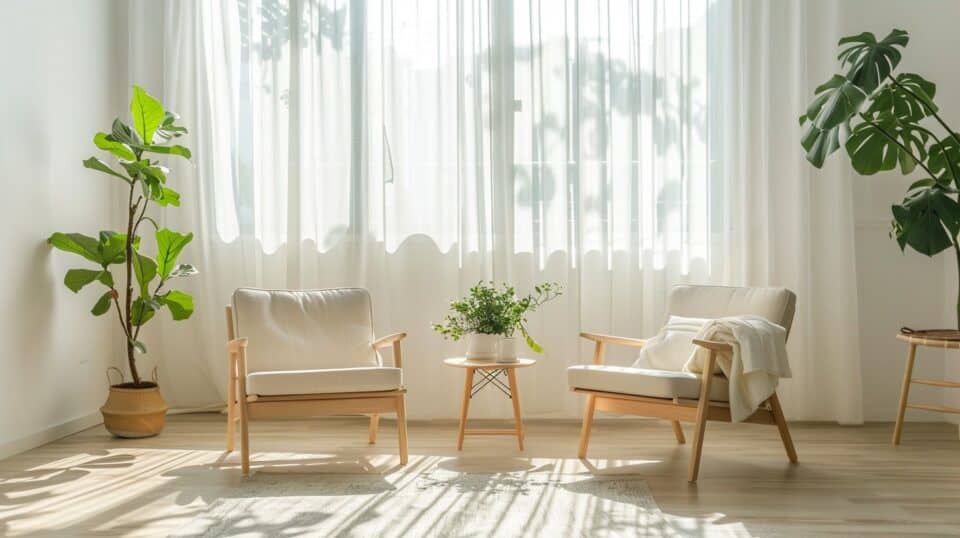
Living with less stuff means more room for happiness and breathing space. It cuts down on cleaning time, saving you money and boosting your love for home life.
Enhanced Functionality of Spaces
Maximizing your home’s spaces makes every room work better for you. Think of your living room not just as a place to watch TV, but as a spot for game nights, reading corners, or even a temporary yoga studio.
This clever use of space means parents can stay active in their hobbies without needing extra rooms or storage areas.
Creating zones within each area can turn chaotic kitchens into baking centers and homework stations. Suddenly, finding what you need is easier, and keeping it tidy becomes second nature.
This shift towards minimalism doesn’t just clear floors; it clears minds. Parents find more joy in their homes, feeling calm instead of cluttered.
Economic Benefits of Decluttering
Throwing out the clutter can save you a pretty penny. By getting rid of things, you no longer need, you won’t just free up space; you might find treasures to sell or donate. Imagine turning old novels, forgotten fashion items, and last year’s gadgets into cash.
This extra money can boost your budget more than you think.
Cutting down on stuff means less spending in the long run too. Parents often buy duplicates because they can’t find what they’re looking for in a mess. A clear house leads to a clear list of what you actually need, stopping unnecessary purchases dead in their tracks.
Plus, maintaining a clutter-free home lowers upkeep costs and saves hours that would otherwise be spent cleaning up chaos. Who knew that tidying up could lighten both your load and your wallet?
Boosting Home Enjoyment
Making your home more fun starts with getting rid of stuff you don’t need. Think about how much better rooms feel when they’re not packed to the brim. For parents, creating a space where you can relax and play with your kids without tripping over toys or searching for a lost remote is like hitting the jackpot of home living.
It’s about making every square foot work smarter, not harder.
Having less clutter means you have more room for what truly adds joy to your life. Picture turning an ignored corner into a cozy reading nook, or transforming that cluttered basement into a game room where family movie nights take place.
It goes beyond cleaning; it’s reshaping your house to make room for real moments that turn into cherished memories. With less stuff in the way, staying at home becomes an adventure rather than a chore.
FAQs About How to Purge Your House
How do I start purging my house without losing my mind?
Kick things off by tackling one room at a time, like those cluttered bathrooms that have seen better days. Think of it as eating an elephant—one bite at a time! And remember, Rome wasn’t built in a day.
Can purging my house really make it a stress-free sanctuary?
Absolutely! Imagine your home as your personal bubble away from the world’s hustle and bustle. Getting rid of the excess stuff is like clearing the cookies from your brain’s browser—suddenly, everything runs smoother and faster.
What if I’m a stay-at-home mom with minimal free time?
Grab those precious moments during nap time or after bedtime stories for some quick decluttering action. It’s about making the most of what you’ve got—think ninja moves but with cleaning gloves on!
Is burning sage part of purging my house?
While not everyone’s cup of tea, burning sage can be like hitting the refresh button for your home’s vibes. Just make sure to crack open a window unless you want to set off smoke alarms and turn your stress-free sanctuary into a fire drill practice zone!
